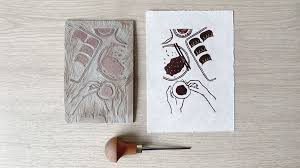Introduction
Lino printing, or linocut, is a printmaking technique that has captivated artists and enthusiasts for over a century. Known for its versatility, simplicity, and bold visual impact, lino printing involves carving an image into a linoleum surface, applying ink, and pressing it onto paper or fabric to create a print. This article delves into the history, process, materials, techniques, and contemporary significance of lino printing, offering a comprehensive overview of this unique and enduring art form.
The History of Lino Printing
Origins and Development
Lino printing traces its roots back to the early 20th century. Linoleum, initially developed in the 1860s as a floor covering, was soon recognized for its potential as a printmaking medium. Unlike traditional woodcuts, linoleum’s smooth, consistent texture and easy workability made it an attractive option for artists.
The technique gained significant popularity in the 1920s and 1930s, particularly among the artists of the German Expressionist movement. Artists like Ernst Ludwig Kirchner and the members of Die Brücke (The Bridge) collective embraced linocut for its ability to produce stark, powerful images. The medium’s affordability and accessibility further contributed to its widespread use.
Evolution and Contemporary Use
Over the decades, lino printing has evolved, with artists experimenting with various techniques and styles. Today, linocut is practiced by professional artists, students, and hobbyists worldwide. Its adaptability and the tactile nature of the carving process continue to inspire creativity and innovation in the art community.
The Lino Printing Process
Materials and Tools
Lino printing requires a few essential materials and tools:
- Linoleum Blocks: The surface onto which the design is carved. Available in different textures and thicknesses, linoleum blocks can be mounted on wood for added stability.
- Carving Tools: Special gouges and knives designed for linoleum cutting. These tools come in various shapes and sizes to achieve different line qualities and textures.
- Ink: Printmaking ink, often oil-based or water-based, is rolled onto the linoleum block with a brayer (roller).
- Brayer: A hand roller used to apply ink evenly to the carved linoleum surface.
- Printing Press or Baren: A printing press provides consistent pressure to transfer the inked image onto paper. A baren, a flat disc, can be used for hand-printing.
- Paper: High-quality, absorbent paper is ideal for capturing fine details of the print.
Step-by-Step Process
- Design Creation: Begin by sketching your design on paper. Once satisfied, transfer the design onto the linoleum block using carbon paper or by drawing directly onto the block.
- Carving: Use carving tools to cut away the areas of the linoleum that will not be inked. The remaining raised areas will form the image to be printed.
- Inking: Roll the brayer in the ink and then evenly apply it to the carved linoleum block. Ensure that the ink covers all raised surfaces without filling the carved-out areas.
- Printing: Place the inked block face-up on the press or flat surface. Carefully lay the paper on top of the block. If using a press, apply consistent pressure to transfer the ink onto the paper. If printing by hand, use a baren or another flat, smooth object to rub the back of the paper, ensuring even pressure across the block.
- Drying and Finishing: Gently peel the paper off the block and set it aside to dry. Depending on the ink type, drying times may vary. Once dry, the print can be framed, displayed, or used in various art projects.
Techniques and Styles
Black and White Prints
Black and white lino prints are the most traditional and widely recognized style. The stark contrast between the ink and paper highlights the bold, graphic nature of the medium. Artists often use this style to emphasize strong lines, shapes, and textures.
Contemporary Significance
Artistic Expression
Lino printing remains a powerful medium for artistic expression. Its tactile, hands-on nature appeals to artists who enjoy the physicality of carving and printing. The medium’s versatility allows for a wide range of styles, from abstract and experimental to detailed and realistic.
Educational Value
Lino printing is widely used in art education due to its accessibility and the fundamental printmaking skills it teaches. Students learn about design, carving, inking, and printing processes, gaining a deeper understanding of printmaking principles. The simplicity of materials and tools makes it an ideal introduction to printmaking for all ages.
Community and Cultural
Lino printing also plays a significant role in community and cultural projects. Workshops and collaborative printmaking sessions bring people together, fostering creativity and connection. In many cultures, linocut prints are used to convey social and political messages, making the medium a powerful tool for advocacy and communication.
Challenges and Rewards
Challenges
Lino printing, like any art form, presents certain challenges. Carving requires precision and control, and mistakes can be difficult to correct. The inking and printing processes demand patience and consistency to achieve clean, even prints. Additionally, multi-color printing requires meticulous planning and registration to ensure proper alignment of colors.
Rewards
Despite these challenges, lino printing offers numerous rewards. The satisfaction of creating a print from start to finish, the tactile joy of carving, and the excitement of pulling a print off the block are deeply fulfilling. The ability to produce multiple copies of a design also allows artists to share their work more widely and affordably.
Also Read : VyvyManga
Conclusion
Lino printing is a vibrant, enduring art form that continues to inspire artists and enthusiasts worldwide. Its rich history, versatile techniques, and accessibility make it a beloved medium for both professional artists and hobbyists. Whether creating bold, graphic images or intricate, multi-color prints, lino printing offers endless possibilities for creative expression. As artists continue to explore and innovate within this medium, lino printing will undoubtedly remain a cornerstone of the printmaking world for generations to come.

